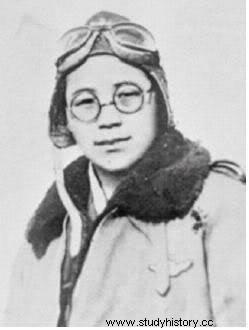Korean independence activist Kwon Ki-ok (1901 – 1988) is also the first aviator in Korea and China.

The birth of a vocation
 Born on January 11, 1901 in the village of Sangsugu near Pyongyang (Korea), Kwon Ki-ok is the second child of Jang Mun-myeong and Gwon Don-gak. She attended Sunghyeon School, where she graduated in 1918.
Born on January 11, 1901 in the village of Sangsugu near Pyongyang (Korea), Kwon Ki-ok is the second child of Jang Mun-myeong and Gwon Don-gak. She attended Sunghyeon School, where she graduated in 1918.
In 1917, Kwon Ki-ok attended an aerobatic demonstration performed by American pilot Art Smith. Impressed and inspired by the performance, she decides to learn to fly herself.
The March 1 Uprising
In 1919, Kwon Ki-Ok took part in the March 1 Uprising. Following the death of King and first Emperor of Korea Kojong (husband of Queen Min), rumors of poisoning by the Japanese circulate and a popular demonstration breaks out against the Japanese occupation. The repression will be terrible, causing 7,000 deaths and 40,000 arrests.
Kwon Ki-Ok is one of the arrested, and spent three weeks in prison. On her release from prison, she got involved in a Korean women's patriotic association; this commitment earned him a new arrest and six months in prison.
First aviator in China and Korea
Freed, Kwon Ki-Ok goes into exile in China and enrolls in a school for women in Hangzhou. In two years, she completed a four-year program and learned Chinese and English. On the recommendation of the Provisional Government of the Republic of Korea in Shanghai, Kwon Ki-Ok joined the first promotion of the Air Force School of the Republic of China in 1923; she is the only woman there. In 1925, she was among the school's first graduates and became the first female aviator in China and Korea.
After graduating, Kwon Ki-Ok was stationed in Beijing for a while before being sent to Nanjing. In 1940, she was promoted to lieutenant-colonel. After World War II and Korean independence, Kwon Ki-Ok returned to Korea where she played an important role in the establishment of the Republic of Korea Air Force.
End of career
During the Korean War (1950 – 1953), Kwon Ki-Ok worked for the South Korean Ministry of National Defense. After the war, she left military life and became vice-president of the China-Korea cultural association in 1966; it will remain so until 1975.
Kwon Ki-Ok on April 19, 1988; she is buried in Seoul. She has received numerous awards for service to her country, including the Order of Merit for the National Foundation and a nomination as "Independence Activist of the Month" by the Department of Patriots and Veterans Affairs. P>
